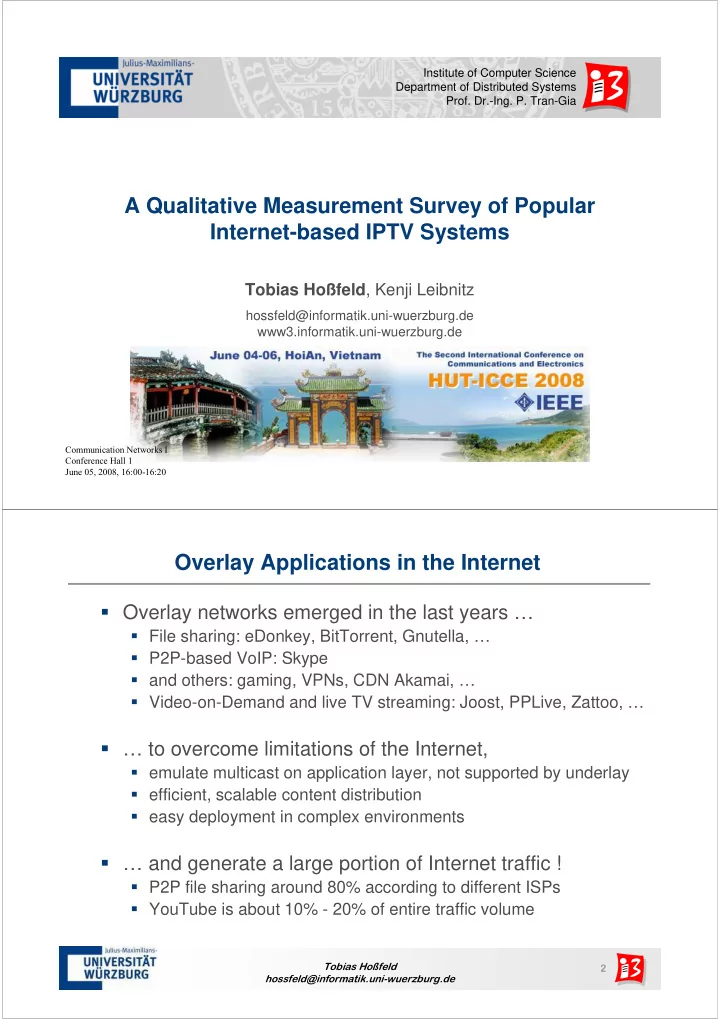

Institute of Computer Science Department of Distributed Systems Prof. Dr.-Ing. P. Tran-Gia A Qualitative Measurement Survey of Popular Internet-based IPTV Systems Tobias Hoßfeld , Kenji Leibnitz hossfeld@informatik.uni-wuerzburg.de www3.informatik.uni-wuerzburg.de ������������������������ ����������������� �������������������������� Overlay Applications in the Internet � Overlay networks emerged in the last years … � File sharing: eDonkey, BitTorrent, Gnutella, … � P2P-based VoIP: Skype � and others: gaming, VPNs, CDN Akamai, … � Video-on-Demand and live TV streaming: Joost, PPLive, Zattoo, … � … to overcome limitations of the Internet, � emulate multicast on application layer, not supported by underlay � efficient, scalable content distribution � easy deployment in complex environments � … and generate a large portion of Internet traffic ! � P2P file sharing around 80% according to different ISPs � YouTube is about 10% - 20% of entire traffic volume �������������� � ������������������������������������
QoE and Application Requirements � Internet traffic transported according to a “best effort” approach � However, some overlay applications such as IP-TV, VoD, VoIP, videoconference or gaming present strict requirements in terms of delay and/packet loss � Quality of Experience � Example: iLBC codec T. Hossfeld, D. Hock, P. Tran-Gia, K. Tutschku, M. Fiedler Testing the IQX Hypothesis for Exponential Dependency between QoS and QoE. ITC Specialist Seminar, Karlskrona, 2008 �������������� � ������������������������������������ The SmoothIT Project � Overlay applications and requirements: QoE++ � Operator’s Point of View: Costs-- � New Approach for Overlay Traffic Management: combine QoE, Costs, Security through Incentives Partners : Coordinator: Prof. Dr. Burkhard • University of Zurich (CH) Stiller (University of Zürich) • Technische Universität Darmstadt (DE) Identify traffic characteristics and requirements Identify traffic characteristics and requirements Duration: Jan, 2008 – Dec, 2010 • DoCoMo Communications Laboratories Europe GmbH (DE) •for popular IPTV systems in order •for popular IPTV systems in order Total Cost: €4.4m • Athens University of Economics and Business (GR) EC Contribution: €3.0m •to assess parameters for good QoE •to assess parameters for good QoE • Julius-Maximilians Universität Würzburg (DE) • AGH University of Science and Technology (PL) •to model IPTV for performance evaluation •to model IPTV for performance evaluation • PrimeTel Limited (CY) http://www.smoothit.org • INTRACOM S.A. Telecom Solutions (GR) • Telefónica Investigación y Desarrollo (ES) Contract Number: INFSO-ICT-216259 �������������� � ������������������������������������
Outline � Classification by Architecture: Client/Server vs. Peer-to-Peer � Overview of IPTV Types � Measurement Results � Centralized Systems: OnlineTVRecorder, YouTube � P2PTV Systems: Joost, Zattoo, PPLive � Comparison � Conclusions �������������� � ������������������������������������ Problems in Centralized Systems � Scalability � more services: multimedia, video, ... � millions of users � more required resources: bandwidth, memory storage, CPU � QoS and QoE � jitter for video streaming � congestion due to flash crowd effects � Flexible, adaptive, cheap network and service elements � Peer-to-Peer �������������� � ������������������������������������
Why using P2P for Live TV or Video-on-Demand? � P2P technology successfully applied in the Internet � BitTorrent, eDonkey: efficient exchange of large contents, even in flash crowd scenarios, scalability � Skype VoIP: smart, adaptive mechanisms (codec, bandwidth, application layer re-routing), edge-based intelligence � Distributed Hash Tables, e.g. Chord: efficient, robust lookup system, self-organization of nodes in structured overlays � Reason for the success of P2P systems? � Popularity due to free applications � many users � Resources of users are utilized in system (bandwidth, memory usage, CPU power) � reliability & availability � High-speed Internet access (DSL), tariff models (flat rate) � How to use P2P technology for IPTV? Performance of P2PTV? �������������� ������������������������������������ Example: OnlineTVRecorder � on average 8.8 Mbyte/minute required � storing contents for 20 TV channels of 1 week: 1.7748 TByte � study of Goldmedia: � in 2010, world-wide number of subscribers is 60 millions � � 2.8160 TByte/s required to serve all users � P2P solution requires per peer a capacity of 0.7395 MB �������������� ! ������������������������������������
Classification by Type of Content Distribution #$�% ��������� ������������� �����������% %�& ���������'����� ����� ��������� �������� �����'��� �����'��� -�������������� -�������������� -�������������� -�������������� $�(��'���)�(�� $�(��'���)�(�� $�(��'���)�(�� $�(��'���)�(�� ,�������'���� ,�������'���� ,�������'���� ,�������'���� C/S P2P ������������� ������������� ������������� ������������� ,�������������( ,�������������( ,�������������( ,�������������( #$�)�(�� #$�)�(�� #$�)�(�� #$�)�(�� C/S P2P ,���������� ,���������� ,���������� ,���������� .������%/�'����� .������%/�'����� .������%/�'����� .������%/�'����� $�$0�6����� $�$0�6����� $�$0�6����� $�$0�6����� $�$0�1���� $�$0�1���� $�$0�1���� $�$0�1���� *++��'������)�(�� *++��'������)�(�� *++��'������)�(�� *++��'������)�(�� $�$0�$$)�-� $�$0�$$)�-� $�$0�$$)�-� $�$0�$$)�-� 2340�5������ 2340�5������ 2340�5������ 2340�5������ �������������� " ������������������������������������ Outline � Classification by Architecture: Client/Server vs. Peer-to-Peer � Overview of IPTV Types � Measurement Results � Centralized Systems: OnlineTVRecorder, YouTube � P2PTV Systems: Joost, Zattoo, PPLive � Comparison � Conclusions �������������� 78 ������������������������������������
Comparison of Centralized Systems � OnlineTVRecorder.com � YouTube � web-based personal video � video sharing web site with user-created contents � recorder, storing contents online � download of files video-on-demand streaming � resolution: 512 x 384 � resolution: 320 x 240 � download: up to 1 Mbps via � download: 320 kbps via TCP TCP from mirror servers � business model: commercials during shows, tons of advertisements on servers, but service is for free! � registration of users required �������������� 77 ������������������������������������ Measurement Results for Centralized Systems � OnlineTVRecorder.com � YouTube video streams � Analytical evaluations with models based on measurement data �������������� 7� ������������������������������������
Recommend
More recommend